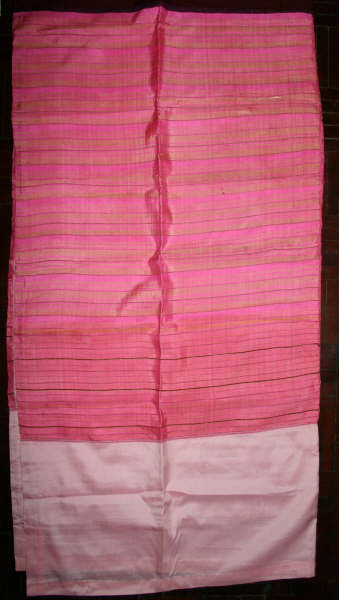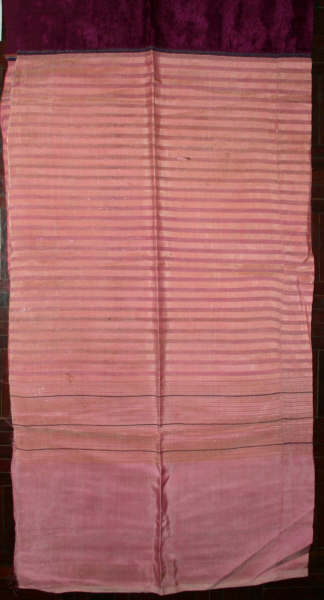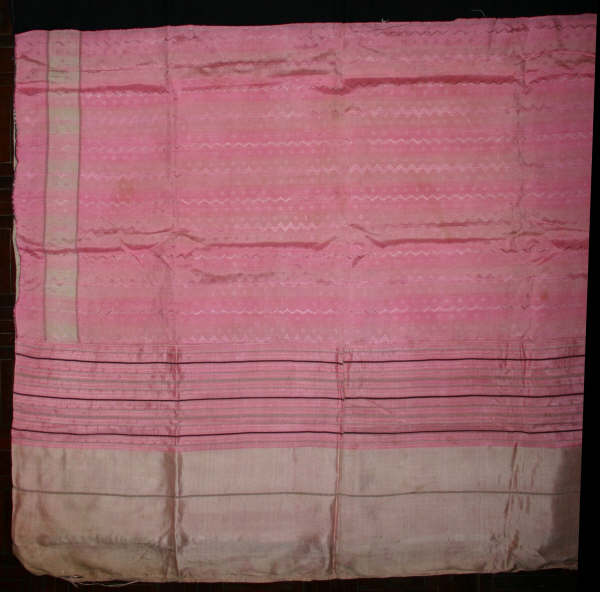Posted by Filiberto Boncompagni on 02-07-2006 06:06 AM:
Any early examples?
Fascinating textiles, thank you Walter.
You speak of “traditional patterns” and “modern ones”, so I wonder if there
are early examples of this kind of weavings in private collections or Museums.
Are you aware of them? If so, do you have any access to some related images?
Best regards,
Filiberto
Posted by Steve Price on 02-07-2006 06:55 AM:
Hi Filiberto
Walt's modern phasins are very much in the traditional mode. You can see some
examples of older T'ai skirts here
Regards
Steve Price
Posted by Walter_Davison on 02-08-2006 05:41 AM:
Hi Filberto,
In fact, I do have access to older pieces as well, thanks to some very friendly
Thai acquaintances. I was allowed to photograph an entire collection of old
pieces in a private collection from the Lan Na period before 1900.
Here are two examples of the many phasins that belong to that collector, Ajarn
Udom Chaithong, Head of the Dept. of Parasitology, Faculty of Medicine, at Chiang
Mai University. He graciously gave me permission to show them. Many of the items
from Ajarn Udom's collection are from the Lan Na Royal Court and are mostly
family heirlooms.
The first one is a silk phasin, with a cotton waistband, worn by Tai Lui and
Tai Khoen women in the eastern Shan States and in Lan Na from the area of what
is now present day Burma. Ajarn Udom told us it is more than 100 years old.
Compare this silk phasin with the cotton one that he advised us to purchase
(pictured in the main salon) as a good example of Tai Khoen work.

Also, if you have Susan Conway's text, "Silken Threads Lacquer Thrones .", available
to you, this phasin is a silk version of the phasin shown on page 167.
The second one, also more than 100 years old, is an example of a beautiful silk
ikat (in Thailand called "matmi" or "mudmee" depending on the transliteration)
weaving. This phasin is from the Chiang Mai area of northern Thailand. Mudmee
weavings are more commonly associated with the Tai Lao groups who settled mainly
in Isan, the northeastern part of Thailand, and that makes this Chiang Mai piece
stand out as unusual.

Walt
Posted by Walter_Davison on 02-09-2006 05:48 AM:
Hi Filiberto,
Regarding old textiles from the Lan Na period, here are pictures of nine phasins
that were, as I understand it, used exclusively at the Royal Court. All of these
examples are in the collection of Ajarn Udom, and they were all made more than
100 years ago.
There are several distinguishing features of these phasins. First, what they
all have in common is the color pink, and that, I was told, was generally reserved
for the Royal Court. Second, they
are all silk, an expensive fabric that only wealthy people or those
associated with the royal court could afford, and third, several of these examples
show a pattern known as "luntaya," a haracteristic wavy line Burmese pattern.
The first two have silver threads imbedded in them and, according to Ajarn Udom,
were made for the Royal Court.


Two more with horizontal stripes for the court.


This next one has the Burmese luntaya design.

This next one, with a luntaya design, was to be worn by a man.

Another with the luntaya design.

And finally in this series of royal court pink silk phasins are two examples
with Ajarn Udom's photograph of the former owner.
Princess Dararatsami, daughter of Prince Indra Witchayanon, the seventh ruler
of Chiang Mai from 1871 to 1897, became the fifth consort of King Rama V of
Siam at the Bangkok Court in 1886. This was part of the initial integration
of Lan Na and the Kingdom of Siam that was necessary to stave off both British
and French interests in the area. The French annexed Laos in 1893 and even more
threatening were the British who occupied India (and Burma), but Siam, and Lan
Na, were able to escape colonization.
Princess Dararatsami is featured prominently, four different photographs, in
Susan Conway's text, Silken Threads..., as a person who greatly influenced
court fashion and as a designer of Lan Na inspired textiles. This is Ajarn Udom's
personal photograph of her.

Ajarn Udom said these two phasins belonged to her and that the second one is
about 150 years old.


Walt
Posted by Filiberto Boncompagni on 02-10-2006 02:46 AM:
Hi Walt,
So they had a “Court” production besides the village one? Or they made special
orders to the villages?
And what about dyes? Are there examples of pre-synthetic dyes era?
Did the weavers used to spin and dye the silk and cotton themselves?
I guess that nowadays they use industrially produced yarns, isn’t it?
Typical rug-biased questions, I know… 
Regards,
Filiberto
Posted by Walter_Davison on 02-11-2006 06:56 AM:
Hi Filiberto,
I thought someone might ask about the dyes, so I searched the texts available
to me to find an answer, and though I myself cannot attest to whether these
old phasins were made with natural dyes, I think they must have been. The overall
situation is probably somewhat analogous, though not completely, to that of
Turkoman rug making with an important difference. That difference is that phasins
for the royal courts could not have been subject to the commercialism that Turkoman
rugs were. There was, after all, a limited group of consumers. So IMHO these
old phasins have natural dyes, but I can't swear to it.
Susan Conway, in her book, Thai Textiles (British Museum Press, 1992) devotes
twelve pages to a discussion of different kinds of natural dyes used in phasins,
including a list of more than 30 plants used to derive various colors. But she
concludes the discussion with these sentences:
"Vegetable dyes and natural substances for mordants were used exclusively in
Thailand until the nineteenth century when synthetic chemicals were introduced.
There are no precise dates for aniline dyes reaching Thailand, but it is thought
that a purple aniline dye was first imported into China in about 1870 followed
soon after by cerise pink. . By the middle of the twentieth century aniline
dyes were common, except for the more remote areas."
Sound familiar?
In her 2002 book, Silken Threads, (Riverbooks, Bangkok), p 180, she adds
that the first trading records listing aniline dyes imported from Bangkok appeared
in 1893.
Songsak Prangwatthanakum and Patricia Naenna in their text, Lan Na Textiles
(Center for the Promotion of Arts and Culture, Chiang Mai University, Bangkok,
April, 1990) describe natural dye usage over seven pages, and here's what they
say:
"Natural dyes have been used in the past . but today very few weavers bother
with the arduous task of the preparation processes, which for some colors can
take years of planning. . The Natural dye which is still used extensively today
by the Tai Lao and the Tai Lue is indigo."
There is an effort here to maintain, and revive, traditional arts, and the use
of natural dyes is part of that endeavor. At a trade show here in Bangkok featuring
up-country products (lots and lots of hand-spun fabrics), I saw one booth extolling
natural indigo dye fabrics and indigo dyed mudmee weavings. At another booth,
I saw a beautiful phasin complete with teen chok which the dealer said was made
with 100% natural dyes. The cost of that one would have offended by better half,
so I wasn't much tempted.
So, in sum, I think the dye situation here is not that much different from what
you can see elsewhere.
In regard to the question about whether the royal courts had their own weavers,
I think the answer has to be "yes." For one thing, the local weavers would not
have had access to the expensive materials and long-planning process needed
to produce royal court products.
Susan Conway, in another publication, Power Dressing: Lanna Shan Siam 19th
Century Court Dress (The James H.W. Thompson Foundation, 2003, p. 5 in the
introduction) writes
". Lanna princesses supervised weaving, dyeing and embroidering in the court
workshops and oversaw the production of dress, textiles and household furnishings."
Elsewhere in the text reference is made to sumptuary laws that codified class
differences which would ensure no one was dressed inappropriately. That makes
good sense for societies that depend on class differentiation. So these factors
together would, I think, have to entail the use of court workshops, even if
no reference were made to them, but as pointed out above, they are referenced.
Walt












